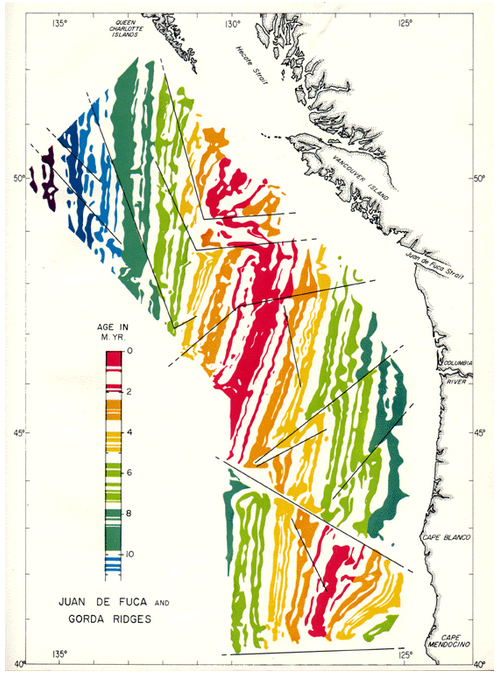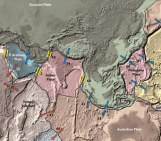
In his 1968 paper “Rises, Trenches, Great Faults, and Crustal Blocks”, Jason Morgan added the missing pieces of the plate tectonics: the representation of plates’ motion in terms of spherical surface, and plate rigidity. In the very first lines of the paper he describes his contribution as an “extension of the transform fault concept [of Wilson, 1965; see the TS-must-read blogpost of October 15, 2020] to a spherical surface”; what he did not know at that time was that McKenzie and Parker (1967) were independently developing the same theory, albeit employing a different approach (see the TS-must-read blogpost of September 30, 2020).
The common ground knowledge to their work were the preceding findings of Dietz, Vine, and Wilson (Dietz, 1961, see the TS-must-read blogpost of September 2, 2020; Vine and Matthews, 1963; Morley and Larochelle, 1964; Wilson, 1965; Vine, 1966): sea-floor spreading is accommodated as lateral motion along transform faults and as crustal ‘destruction’ at compressive-type boundaries (i.e. subduction zones and mountain belts), and geomagnetic anomalies can be used to calculate the sea-floor spreading rates.

Figure 1. Diagram showing the magnetic anomalies in the Juan de Fuca region, offset by faults (straight lines). From Vine (1966).
The contribution first illustrates how to calculate the motion of rigid plates by using the Euler rotation theorem, and identifies the three types of plate boundaries (rises, trenches, and great -transform- faults) along which motion occurs. The new, grounding assumption in Morgan’s contribution, which gave the model mathematical rigor, is that oceanic blocks have the same rigidity as continental blocks, so that the distance between two points on the same block shall remain constant over time.
Morgan then calculates the rates of relative motion of the major lithospheric blocks by using magnetic profiles (Fig. 1). With a comparison between the position of transform faults and the ridge-perpendicular direction of motion, the author was able to discriminate whether the most recent observed movement was long-term, or if geometries indicating old kinematics existed. Large errors in calculated spreading rates allowed him to propose the existence of ‘highly fractured regions’ where calculations could not be verified due to a lack of data.
As for McKenzie and Parker (1967), Morgan’s paper tackles plate tectonics from a purely kinematic point of view. The paper offers some speculation about the driving mechanisms of plate tectonics in the conclusions but nothing definitive is stated; as we know, this concept will remain in contention until more recent times.
This paper provided a basis for decades of research not only for tectonics, but also for other geoscience fields such as seismology. Scientists exploring the global distribution of seismicity were, partly thanks to this paper, able to analyse earthquake patterns in the context of the type and kinematics of plate boundaries along which the events were located.
Gianluca Frasca and Armin Dielforder participated in the discussion on reddit, highlighting Morgan’s remarkable capability of abstraction and understanding despite the limited amount of data available. However, the spotlight remains on the question: how rigid are rigid blocks? Whereas modern plate reconstruction methodologies now allow internally deforming plates (e.g. Gurnis et al., 2018), for the purpose of Morgan’s paper the rigid blocks concept was a reasonable assumption, and not too far from reality, as GPS later on showed. More generally, understanding the physics of plate tectonics from plate kinematic reconstructions remains challenging and uncertainties in the timing of magnetic reversals may lead to contrasting geodynamic interpretations (Pérez-Díaz et al., 2020).
Written by Silvia Crosetto, Armin Dielforder, Folarin Kolawole, and the TS Must Read team
References
Dietz R.S. (1961) Continent and ocean basin evolution by spreading of the sea floor. Nature, 190,854-857.
Gurnis M., Ting Yang, Cannon J., Turner M., Williams S., Flament N., Müller R.D. (2018) Global tectonic reconstructions with continuously deforming and evolving rigid plates. Computers & Geosciences, 116, p. 32-41, https://doi.org/10.1016/j.cageo.2018.04.007.
McKenzie D.P. and Parker R.L. (1967) The North Pacific: an example of tectonics on a sphere. Nature 216.5122: 1276-1280.
Morgan W. J. (1968). Rises, trenches, great faults, and crustal blocks. Journal of Geophysical Research, 73(6), 1959-1982.
Morley L. and Larochelle A. (1964) Paleomagnetism as a means of dating geological events. In: Geochronology in Cunuda (ed. by F. Fritz Osbome), pp. 39-50. Spec. Publ. Royal Society of Canada No. 8, Toronto.
Pérez-Díaz L., Eagles G., Sigloch K. (2020) Indo-Atlantic plate accelerations around the Cretaceous-Paleogene boundary: A time-scale error, not a plume-push signal. Geology, doi: https://doi.org/10.1130/G47859.1
Vine F. and Matthews D.H. (1963) Magnetic anomalies over ocean ridges. Nature, 199, 947-949.;
Vine F. (1966) Spreading of the ocean floor: new evidence. Science, 154, 1405-1415
Wilson J.T. (1965) A new class of faults and their bearing on continental drift. Nature, 207, 343-347


